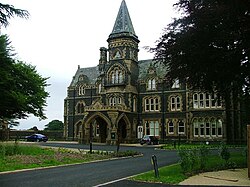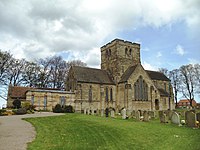Nunthorpe
| Nunthorpe | |
| Yorkshire North Riding | |
|---|---|
 Grey Towers, Nunthorpe | |
| Location | |
| Grid reference: | NZ532151 |
| Location: | 54°31’43"N, 1°10’37"W |
| Data | |
| Population: | 4,866 (2011) |
| Post town: | Middlesbrough |
| Postcode: | TS7 |
| Dialling code: | 01642 |
| Local Government | |
| Council: | Middlesbrough |
| Parliamentary constituency: |
Middlesbrough South and East Cleveland |
Nunthorpe is a village in the North Riding of Yorkshire, in the very north of the county, approaching the River Tees.
Close by is the village of Great Ayton: both villages were historically part of the ancient parish of Ayton.[1]
History
The Domesday Book of 1086 records the village as "Torp" (‘Thorpe’). The name simply means ‘village’). As recorded, it appears to have been a thriving settlement: the manor consisted of an estimated 1,080 acres of land.
Towards the end of the 12th century a group of Cistercians nuns, allegedly evicted from nearby Hutton Lowcross for rowdy behaviour, were resettled at Thorpe having been given some land there belonging to Whitby Abbey, on which they built a priory and mill. The nuns only stayed at Thorpe a few years, but their short stay resulted in Thorpe being renamed ‘Nunthorpe’. During the following centuries, Nunthorpe remained an agricultural community closely linked to the market towns of Stokesley and Ayton. The Industrial Revolution had very little impact on its agricultural economy.

The census of 1811 shows Nunthorpe to have had a population of 128, living either in the village of Nunthorpe or on nearby farms. Nunthorpe was at that time registered as being in the North Riding of York, in the Parish of Great Ayton. Its economy was all related to agriculture and farming. The rapid growth of Middlesbrough from a population of 35, in 1811, to a population of 91,302, in 1901 appeared to have had little effect on Nunthorpe, which kept its agricultural throughout the 19th century. Nunthorpe's population in comparison only reaching 198 persons by 1901.
In 1853, the Middlesbrough and Guisborough Railway line opened, with a station at Nunthorpe and passenger services the following year. Several important Middlesbrough industrialists chose Nunthorpe as their home and contributed to the development of the village. These men included Isaac Wilson, ironmaster, Mayor of Middlesbrough and later Liberal MP, John Swan, ironmaster, William Hopkins, ironmaster and mayor of Middlesbrough and Sir Arthur Dorman, ironmaster.

The settlement that is known as Nunthorpe today is that which grew up around the railway station: Nunthorpe village, the original, is about a mile south of the main suburban area. In the early 20th Century, Sir Arthur Dorman planned and built a new small suburb around the railway station for his workers He imposed several covenants on the building: – shops were not permitted, public houses were also not allowed, the houses had to have slate roofs and were not permitted to have house numbers. The layout included tree-lined roads, with spacious houses, each with a garden built in terraces. The houses were certainly an improvement on the small workers' houses built in Middlesbrough. By 1912, about 60 houses had been built around the station area of Nunthorpe.
New housing estates, schools and churches were built during the late 1950s, 1960s and 1970s.. The historical development of Nunthorpe initially started with the building of generously sized houses in generous gardens. This has given Nunthorpe its continued heritage with an open and spacious character.
Churches

- Church of England: St Mary the Virgin, on Church Lane
- Methodist: Nunthorpe Methodist Church, on Marton Moor Road
- Roman Catholic: St Bernadette's, on Gypsy Lane
About the village
Nunthorpe Hall
Nunthorpe Hall is the ancient manor house in Nunthorpe village. It was built in 1623, and largely rebuilt and extended in around 1800 and altered again in the mid-1800s. The entrance porch and was added in 1901. The building was converted into a retirement home for the elderly in 1951. The main building is of dressed sandstone, with Lakeland slate roofs, with stone ridge copings. It became a Grade II, listed building, in 1952.[2]
Grey Towers
Grey Towers House is a large house, built in 1865 for William Hopkins, Mayor of Middlesbrough. It has an unusual aspect in that it is faced with whinstone, compared to the traditional sandstone of the area. Arthur Dorman, of the steel makers Dorman Long, lived there until his death in 1931.
Alderman Sir Thomas Gibson Poole bought the estate and presented it to Middlesbrough Council as a tuberculosis sanatorium, known first as Poole Sanatorium, and later as Poole Hospital. It was opened as a hospital, first in 1932, and expanded with further buildings, in 1945. It closed as a hospital in 1988.[3] In 1988, it also became a Grade II* listed building.[4]
In 2005, Grey Towers Hall was refurbished into 12 apartments
Sport and culture
Nunthorpe has a squash and football club, complete with squash and tennis courts; there is also a cricket club.[5] The Cleveland Hills can be seen as the backdrop to this local amenity, with Roseberry Topping clearly visible.
An amateur drama group, The Nunthorpe Players, founded in 1962, regularly performs at St. Mary's Church Hall in Nunthorpe.
Outside links
| ("Wikimedia Commons" has material about Nunthorpe) |
References
- ↑ "Nunthorpe CP/Ch". https://www.visionofbritain.org.uk/unit/10457555.
- ↑ National Heritage List 1139809: Nunthorpe Hall (Grade II listing)
- ↑ "Timeline 19th and 20th century". Nunthorpe History Group. http://www.nunthorpehistorygroup.org/nunthorpe_history_timeline.htm.
- ↑ National Heritage List 1139813: Grey Towers House (Poole Hospital) and Attached Wall (Grade II* listing)
- ↑ "Nunthorpe & Marton Recreation Club". http://www.nunthorperecreationclub.co.uk/.
